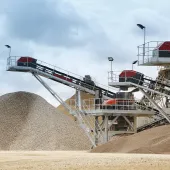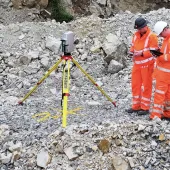A circular economy success story

New MPA analysis illustrates the recycling success story of the GB aggregates industry
THE Mineral Products Association (MPA) has launched a new briefing, ‘The Contribution of Recycled and Secondary Materials to Total Aggregates Supply in Great Britain’, highlighting that the aggregates industry is one of the UK’s recycling and circular economy success stories.
More than 70 million tonnes of materials from a range of sources are reused in GB aggregates markets and 90% of these recycled materials are sourced from construction activity following demolition work and road repairs.
While there is a welcome focus on reducing construction waste, construction in built-up areas and on brownfield sites invariably involves demolition and generates waste materials such as brick and concrete which are reused in aggregates markets. Similarly, asphalt removed during road maintenance work is all reused.
Other materials reused in aggregates markets are sourced from iron and steel making, coal-fired power stations, incineration and china clay and slate extraction.
Government data and MPA research indicate that virtually all potentially reusable materials are now used in the aggregates market. As such, the scope for increasing the use and share of recycled materials in aggregates markets is likely to be incremental and linked largely to the amount of construction and demolition work carried out in the future.
GB’s 29% market share of recycling in aggregates markets is double the European average recycling share of around 15%. The detailed information on recycling in aggregates markets in the new briefing complements an earlier MPA briefing, ‘From Waste to Resource: a UK Mineral Products industry success story’, which highlighted that the headline figure of 120 million tonnes of waste created by the construction industry annually creates a misleading impression of construction ‘waste’ not being in the ‘chain of utility’.
An analysis of the 120 million tonnes of waste indicated that 76% of this waste was recycled and recovered because most of the nominal ‘waste’ was either hard materials such as concrete, bricks and asphalt which were recycled and reused in new construction, or soft materials such as soils and clays resulting from construction groundworks and tunnelling which can be reused positively for activities such as the restoration of quarries.
As such, the volume of potentially ‘avoidable’ waste generated by the construction industry is much smaller than the headline figure of 120 million tonnes – around 26 million tonnes of construction waste are actually sent for disposal annually, including materials such as plastics which now a greater focus of attention.
Commenting, Jerry McLaughlin, the MPA’s executive director of economics and public affairs said: ‘Treating waste materials as a resource is an essential element of the circular economy. Virtually all usable materials arising from construction and demolition work are reused in the GB aggregates market, together with materials arising from a range of other industrial and extraction processes.
‘The use of these materials is not widely appreciated but it represents the largest volume of recycling taking place in Great Britain and the market share of recycling in the domestic aggregates market is twice the European average. This recycling performance helps to ensure the sustainable supply of aggregates into construction markets and is a notable circular economy success story.’
A copy of the new report, ‘The Contribution of Recycled and Secondary Materials to Total Aggregates Supply in Great Britain’ as well as the earlier briefing, ‘From Waste to Resource: a UK Mineral Products industry success story’, can be downloaded below.









